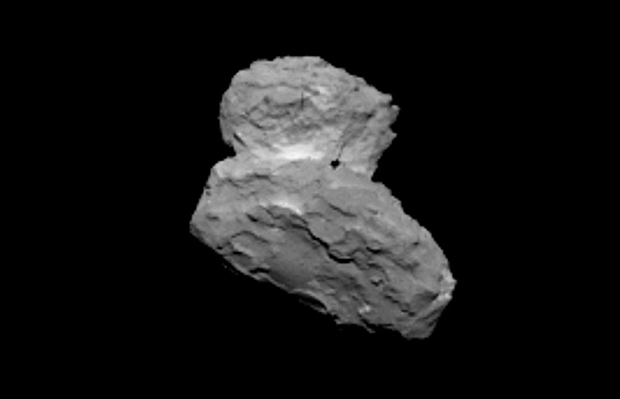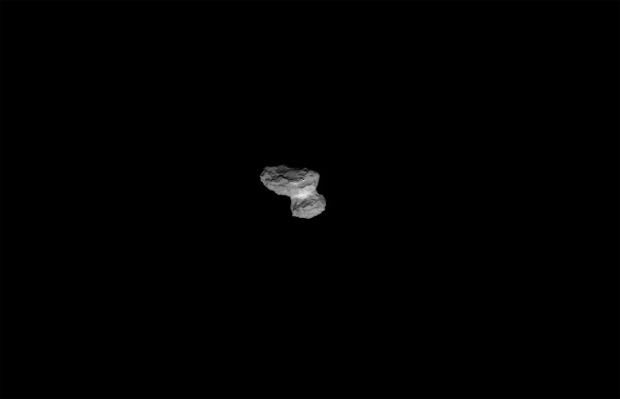Rosetta's comet coming into focus
08/02/2014 02:24 PM Filed in: Space News | Planetary Exploration
By WILLIAM HARWOOD
CBS News
The European Space Agency's $1.7 billion Rosetta probe, closing in on a comet for a historic rendezvous Wednesday, is sending back sharper and sharper views of its quarry, revealing an intriguing relic of the solar system's birth featuring two distinct lobes.
The latest photos from Rosetta's OSIRIS narrow angle camera were taken Friday from a distance of about 620 miles. An image from the spacecraft's wide-angle navigation camera, or NAVCAM, shows a similar view from slightly farther out, with the comet in a different orientation due to its 12.4-hour rotation.
Scientists say the "rubber duck" shape of comet 67P/Churyumov-Gerasimenko could the result of a low-speed collision between two previously independent bodies, forming a so-called contact binary. Or perhaps it's the result of uneven heating and sublimation of ices in its nucleus or the gravitational influence of the sun or Jupiter during its formation.
Long-exposure views of 67P reveal the tenuous cloud of gas and dust that already surrounds the nucleus. The comet is still some 330 million miles from the sun between the orbits of Jupiter and Mars. As it nears the sun, more and more ice trapped in the nucleus will sublimate, turning directly into a gas. Pressure from the solar wind will cause some of that material, along with dust, to stream away in the opposite direction, forming two tails.
Rosetta will match orbits with comet 67P/Churyumov-Gerasimenko Wednesday after a 10-year voyage featuring four velocity boosting planetary flybys, two asteroid encounters and two-and-a-half-years spent in electronic hibernation. It will be the first spacecraft to fly in tandem with a comet as it falls into the inner solar system.
If all goes well, Rosetta will deploy a small lander this Fall that will settle to the surface of the comet and anchor itself in the feeble gravity for in situ observations as 67P heats up in the warmth of the sun. The comet's orbit will carry it inside the orbit of Mars, reaching perihelion, its closest to the sun, on Aug. 13, 2015.
CBS News
The European Space Agency's $1.7 billion Rosetta probe, closing in on a comet for a historic rendezvous Wednesday, is sending back sharper and sharper views of its quarry, revealing an intriguing relic of the solar system's birth featuring two distinct lobes.
The latest photos from Rosetta's OSIRIS narrow angle camera were taken Friday from a distance of about 620 miles. An image from the spacecraft's wide-angle navigation camera, or NAVCAM, shows a similar view from slightly farther out, with the comet in a different orientation due to its 12.4-hour rotation.
 |
| In this narrow-angle view from the Rosetta spacecraft's OSIRIS camera, comet 67P/Churyumov-Gerasimenko's unusual shape is increasingly apparent, showing variations in surface brightness and a mottled appearance. The dark spot near the "neck" between the two lobes is an imaging artifact of the camera. (Credit: ESA) |
Scientists say the "rubber duck" shape of comet 67P/Churyumov-Gerasimenko could the result of a low-speed collision between two previously independent bodies, forming a so-called contact binary. Or perhaps it's the result of uneven heating and sublimation of ices in its nucleus or the gravitational influence of the sun or Jupiter during its formation.
Long-exposure views of 67P reveal the tenuous cloud of gas and dust that already surrounds the nucleus. The comet is still some 330 million miles from the sun between the orbits of Jupiter and Mars. As it nears the sun, more and more ice trapped in the nucleus will sublimate, turning directly into a gas. Pressure from the solar wind will cause some of that material, along with dust, to stream away in the opposite direction, forming two tails.
 |
| A wide-angle shot from Rosetta's navigation camera from slightly farther away. If all goes well, Rosetta will match orbits with the comet Wednesday after a 10-year voyage. (Credit: ESA) |
Rosetta will match orbits with comet 67P/Churyumov-Gerasimenko Wednesday after a 10-year voyage featuring four velocity boosting planetary flybys, two asteroid encounters and two-and-a-half-years spent in electronic hibernation. It will be the first spacecraft to fly in tandem with a comet as it falls into the inner solar system.
If all goes well, Rosetta will deploy a small lander this Fall that will settle to the surface of the comet and anchor itself in the feeble gravity for in situ observations as 67P heats up in the warmth of the sun. The comet's orbit will carry it inside the orbit of Mars, reaching perihelion, its closest to the sun, on Aug. 13, 2015.